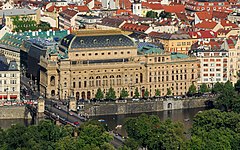Prague National Theater
 |
|
| Address | Národní 223/2 |
|---|---|
| Location | Prague, Czech Republic |
| Coordinates | 50°4′52″N 14°24′48″E / 50.08111°N 14.41333°ECoordinates: 50°4′52″N 14°24′48″E / 50.08111°N 14.41333°E |
| Owner | Ministry of Culture |
| Capacity | 986 |
| Construction | |
| Opened | 1 June 1881 |
| Reopened | 18 November 1883 |
| Rebuilt | 1977–1983 |
| Architect | Josef Zítek |
| Website | |
| http://www.narodni-divadlo.cz/ | |
The National Theatre (Czech: Národní divadlo) in Prague is known as the alma mater of Czech opera, and as the national monument of Czech history and art.
The National Theatre belongs to the most important Czech cultural institutions, with a rich artistic tradition, which helped to preserve and develop the most important features of the nation–the Czech language and a sense for a Czech musical and dramatic way of thinking.
Today the National Theatre consists of three artistic ensembles: opera, ballet and drama. They alternate in their performances in the historic building of the National Theatre, in the Theatre of the Estates and in the Kolowrat Theatre. All three artistic ensembles select their repertoire both from classical heritage, and modern authors.
The cornerstone of the National Theatre was laid on 16 May 1868, but the idea of building a theatre dates back to the autumn of 1844 at the gatherings of patriots in Prague. An application was submitted by František Palacký to the Provincial Committee of the Czech Assembly on 29 January 1845, requesting "the privilege of constructing, furnishing, maintaining and managing" of an independent Czech theatre. The application was granted in April 1845, but it was not until six years later – in April 1851 – that the founding Society for the Establishment of a Czech National Theatre in Prague made the first public appeal to start a collection. A year later the proceeds went toward the purchase of land belonging to a former salt works covering an area of not quite 28 acres (11 ha) which determined the magnificent site of the theatre on the banks of the river Vltava facing the panorama of Prague Castle, but at the same time the cramped area and trapezium shape posed challenging problems for the designers of the building.
The era of von Bach absolutism brought to a halt preparations for the envisaged theatre and supported the concept of a modest provisional building, which was erected on the south side of the theatre parcel by architect Vojtěch Ignác Ullmann and opened on 18 November 1862. The building of the Provisional Theatre then became a constituent part of the final version of the National Theatre; its outside cladding is visible to this day in the elevated section of the rear part of the building, and the interior layout was only obliterated following the latest reconstruction of the National Theatre in 1977 – 1983. Simultaneously with the realization of this minimal programme asserted by F.L. Rieger and the Provincial Committee, the young progressive advocates of the original ambitious concept of the building (Sladkovský, Tyrš, Neruda, Hálek) launched an offensive. In 1865 these men attained leading positions in the Society and requested the 33-year-old professor of civil engineering at the Prague Technical College, architect Josef Zítek, to draft a design for the National Theatre. He then came out on top in a later-declared open competition, and in 1867 construction work began. On 16 May 1868, the foundation stone was laid, and in November the foundations were completed. In 1875, the new building reached its full height and in 1877 the theatre was roofed over. As of 1873 there was an ongoing competition for the interior decoration of the building, the scenario of which had been elaborated by a special commission under the leadership of Sladkovský. On the one hand, the themes were in the spirit of the Neo-Renaissance concept of a classic building. On the other hand, they were inspired by the current enthusiasm for Slavonic mythology and the stories of the Manuscripts; both of these concepts were based on Josef Mánes' paintings and connected with the contemporary style of romantic landscape painting (also linked to Czech history). They provided the fundamental ideology guiding artistic expression, which today is described as the art of the generation of the National Theatre.
...
Wikipedia
